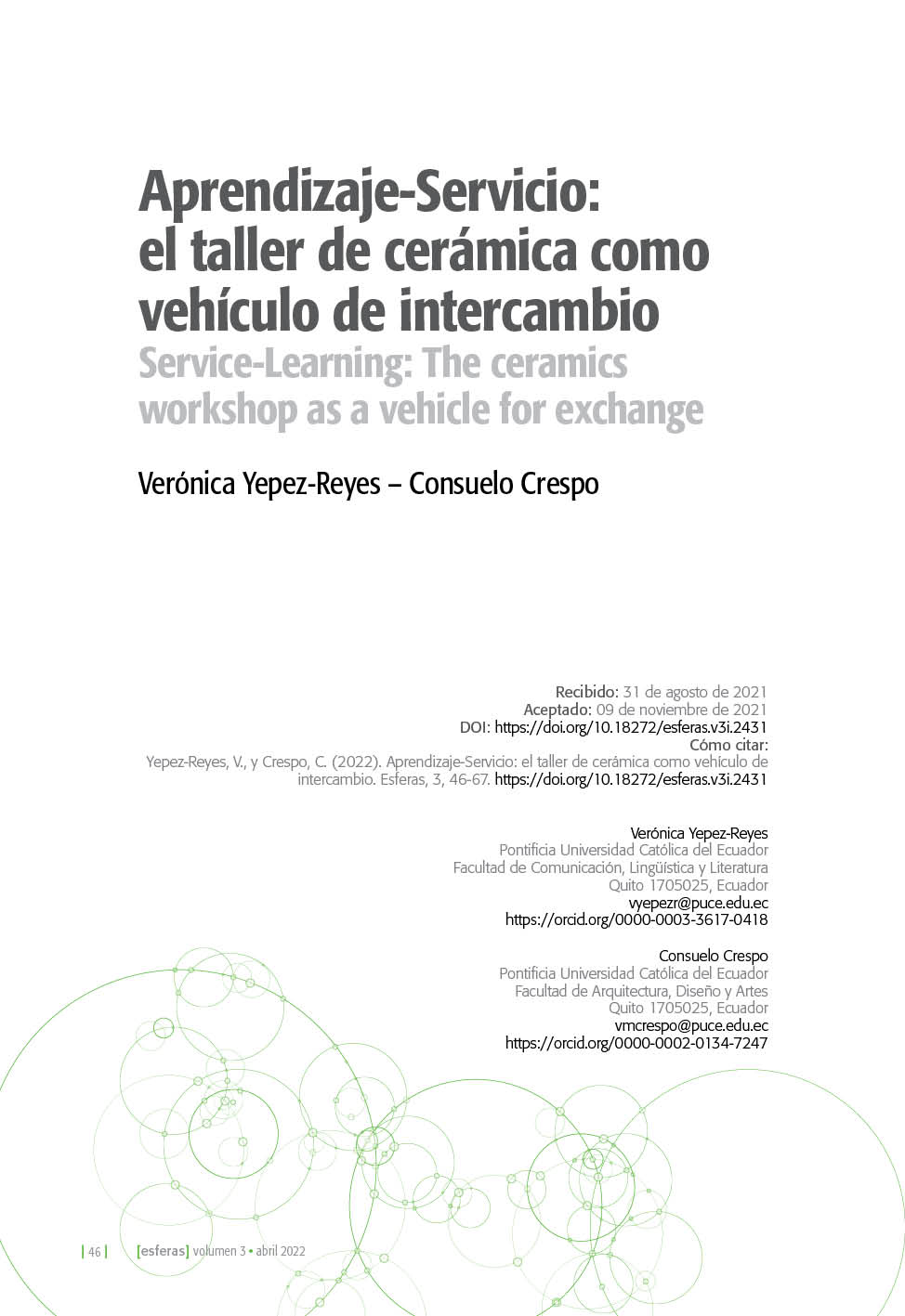Service-Learning: the ceramics workshop as a vehicle for exchange

Published 2022-04-04
Versions
- 2023-02-01 (2)
- 2022-04-04 (1)
Keywords
- Service-Learning,
- ceramics,
- Chugchilán,
- ayni,
- exchange
How to Cite
Abstract
Service-Learning (SL) is an experiential learning methodology that is applied in multiple fields, one of them being the Ceramics Workshop to which this article refers. The Ceramics Workshop arises as a form of artistic expression of the community of Guayama Grande in the Andean páramo of Chugchilán in Cotopaxi. Here, for two and a half years "”before and during the COVID-19 pandemic"”students, teachers and the community have put into practice a methodology based on recovering their memory and revitalizing their language, both of which are fundamental in building their world, with ceramics as the mechanism of interpretation of that world, which has been in "oblivion" for years. The Workshop becomes a vehicle for exchange and mutual learning. This has allowed the emergence of a community image sculptor who, putting into practice the acquired knowledge and the concept of ayni, Andean reciprocity, has been able to share the art of ceramics with other communes and places, promoting well-being (SDG3) and quality education (SDG4).
Downloads
References
- Andrade-Zapata, J. S., y López-Vélez, A. L. (2020). Aprendizaje-servicio en contextos de confinamiento y pandemia: sostener la relación Universidad-Comunidad mediante la presencia virtual. RIDAS. Revista Iberoamericana de Aprendizaje Servicio 10, pp. 89-100. https://doi.org/https://doi.org/10.1344/RIDAS2020.10.8
- Augé, M. (1994). E1 sentido de los otros. Actualidad de la antropología. Paidós.
- Baena Graciá, V. (ed.) (2019). El Aprendizaje Experiencial como metodología docente. Narcea S.A. Ediciones.
- Bagga"‘Gupta, S., & Rao, A. (2018). Languaging in digital global South-North spaces in the twenty"‘frst century: media, language and identity in political discourse. Bandung Journal of Global South 5(3), 1-34. https://doi.org/https://doi.org/10.1186/s40728-018-0047-z
- Baudrillar, J. (1968). El sistema de los objetos. Siglo XXI.
- Boroditsky, L. (2017). How language shapes the way we think. https://www.ted.com/talks/lera_boroditsky_how_language_shapes_the_way_we_think
- Carrasco, Y. (2019). Estadísticas de turistas en laguna de Quilotoa. Conciencia Digital 2, pp. 24-34. https://doi.org/10.33262/concienciadigital.v2i1.927
- Crespo, C. (2017). El taller de cerámica como vehículo de intercambio en un territorio complejo. Index. Revista de Arte Contemporáneo 3, pp. 48-63. https://doi.org/https://doi.org/10.26807/cav.v0i03.50
- Cifuentes, M. (2020). Chugchilán: un Recorrido desde la Historia y la Memoria. [Manuscrito no publicado]. Proyecto Laboratorio de los Paisajes Vivo. Pontificia Universidad Católica del Ecuador.
- Díaz, K., Ramia, N., Bramwell, D., y Costales, F. (2019). Civic Attitudes and Skills Development Through Service-Learning in Ecuador. Journal of Higher Education Outreach and Engagement 23, 124-144. https://openjournals.libs.uga.edu/jheoe/article/view/1524/1461
- Gadamer, H. (1993). Verdad y Método. Fundamentos de una Hermenéutica Filosófica. Hermeneia 7. Ediciones Sígueme.
- Gadamer, H. (1998). Verdad y Método II. Hermeneia 34. Ediciones Sígueme.
- García-Gutiérrez, J., y Corrales Gaitero, C. (2020). Las políticas supranacionales de educación superior ante la "tercera misión" de la Universidad: el caso del aprendizaje-servicio. Revista Española de Educación Comparada 37, 251-280. https://doi.org/10.5944/reec.37.2021.27535
- Haboud, M., Freeland, J., Howard, R., y Cruz, J. (2016). Linguistic Human Rights and Language Revitalization in Latin America and the Caribbean. En S. Coronel-Molina y T. L. McCarty (Eds.), Indigenous Language Revitalization in the Americas, 201-224. Routledge.
- Howard, R. (2011). The Quechua language in the Andes today: Berween statistics, the state and daily life. In P. Heggarty & A. J. Pearce (eds.) History and language in the Andes. Studies of the Americas (pp. 189-213). Palgrave Macmillan.https://doi.org/10.1057/9780230370579_9
- Jacoby, B. (2015). Service-Learning Essentials. Questions, Answers, and Lessons Learned. Jossey-Bass.
- Kolb, D. (1984). Experiential Learning. Experience as The Source of Learning and Development. Prentice-Hall.
- Ministerio de Educación. (2009). Kichwa. Yachakukkunapa Shimiyuk Kamu. https://bit.ly/34gc5tR
- Porras, P. (1972). Breves notas de la arqueología del Ecuador (2.ª ed.). Centro de Publicaciones PUCE.
- Ricoeur, P. (2000). La memoria, la historia, el olvido. Fondo de Cultura Económica.
- Ríos, R., González, J., Armijos E., Borja, K., y Montaño, M. (2016). Estrategias para el arquitecto intérprete: el consultorio en el laboratorio de los paisajes vivos. Arquitecturas del Sur 34 (49), 22-31.
- Rolnik, S. (2006). ¿El arte cura? MACBA Museo de Arte Contemporáneo de Barcelona.
- Skutnabb-Kangas, T., y Phillipson, R. (2010). Linguistic Human Rights: Overcoming Linguistic Discrimination. In S.-K. Tove & P. Robert (eds.) Linguistic human rights, past and present, 71-110. De Gruyter Mouton. https://doi.org/doi:10.1515/9783110866391.71
- Yepez-Reyes, V., y Williams, E. R. (2021). Service-Learning Through Immersive Technologies in Ecuador. Journal of Higher Education Outreach and Engagement 25(2), 177-185. https://openjournals.libs.uga.edu/jheoe/article/view/2509
- Yucra, R. (2016). El Ayni principio fundamental de los incas. Universidad Peruana Cayetano Heredia. Conferencia Magistral "El Ayni" de Juan e Iván Núñez del Prado. https://faedu.cayetano.edu.pe/noticias/1191-el-ayni-principio-fundamental-de-los-incas
